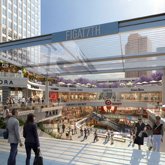Downtown LA Needs Indie Fashion Boutiques
Note to independent fashion boutiques: Downtown Los Angeles wants you.
A study recently released by the Downtown Center Business Improvement District showed the downtown Los Angeles area is being peppered with new expensive restaurants and popular bars, but there’s not a lot of fashion retail.“We’re trying to attract unique and one-of-a-kind retailers rather than retailers found in suburban malls,” said Carol E. Schatz, president and chief executive of the BID, who presented the demographic study in an Aug. 23 press conference.
The study found that downtown Los Angeles has grown in population. There are 45,518 residents of downtown, an increase of 15 percent from 2008. The median age of downtown residents is 33. The median annual income is $86,300, and residents spend a lot of money on dining and entertainment. Schatz said 19 percent of downtown residents are employed in creative jobs in the arts and entertainment field. “We are continuing to build a creative class. They are moving us forward,” she said.
The BID’s survey gathered 11,000 responses from residents, office workers and tourists. About 80 percent of the respondents said they would be extremely or very likely to shop at a Trader Joe’s grocery store if one opened here.
Schatz noted that the BID has asked Trader Joe’s to open a location in downtown Los Angeles. But the popular grocery-store company has shown no interest. “They are tough,” Schatz said of Trader Joe’s executives. “They can make a fortune down here.” A significant number of survey respondents, 37.4 percent, said they wanted a Nordstrom or Nordstrom Rack to open in downtown. Ten percent said they wanted a Banana Republic store in the area. Over the past decade, a handful of retailers have tried, with varying degrees of success, to run fashion boutiques around Fifth and Spring streets, one of the highly trafficked intersections during the popular Downtown Los Angeles Art Walk, held once a month.
Brooke Pace opened her Stanton James boutique at 600 S. Spring St. in March. Business has been good, and she plans to expand the store. Most of her clients work in the fashion industry and are very loyal to neighborhood boutiques. “We have tons of repeat customers. We have become a neighborhood hangout,” Pace said. Joining Schatz in a plea for unique fashion boutiques was Bert Dezzutti, senior vice president of Brookfield Office Properties. The company is developing the $40 million 7thAtFIG retail center, located at 735 S. Figueroa St., where a May Co. department store was located for years. Target Corp. will take over the space and debut a 100,000-square-foot CityTarget store in fall 2012. The CityTargets are geared toward residents of densely populated areas similar to downtown Los Angeles.
“It is not an underserved population,” Dezzutti said of downtown residents’ fashion needs. “It is an unserved population.”
A handful of fashion boutiques currently serves the growing population of young, affluent downtown residents. But Schatz and Dezzutti envision a row of independent fashion retail spanning from the 7thAtFig retail center past the corner of Seventh and Los Angeles streets, several blocks away.
For the past year, the downtown Los Angeles BID has canvassed successful boutiques on high-profile, Los Angeles–area retail streets such as Abbot Kinney Boulevard and Montana Avenue and in the city of Pasadena, asking them to open downtown L.A. locations. There have been no formal incentives to attract boutiques to downtown, according to a BID representative. The Downtown Los Angeles Demographic Study 2011 was produced by the BID and study consultant Horizon Consumer Science, which is based in downtown Los Angeles.Schatz noted that independent retail will make the neighborhood a more attractive place to live and visit.
























